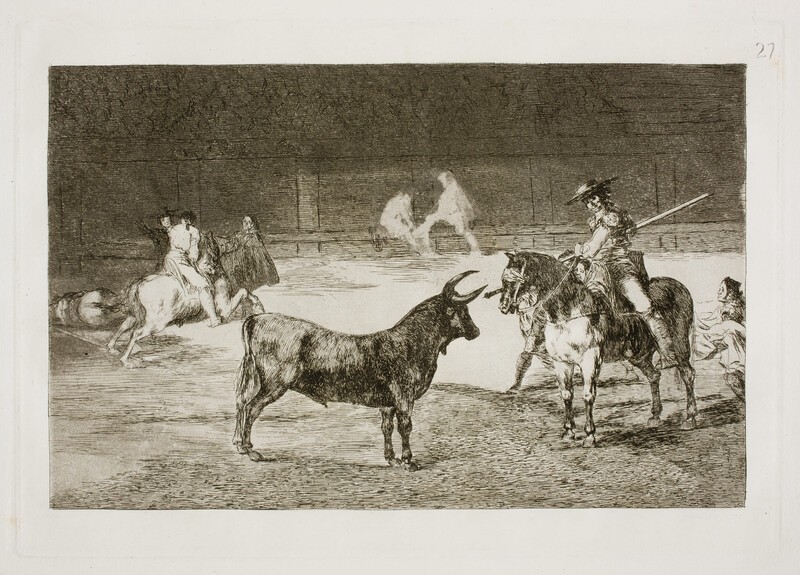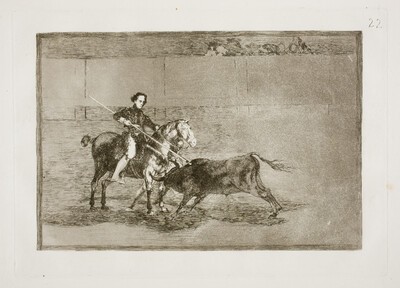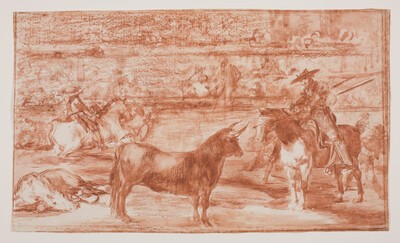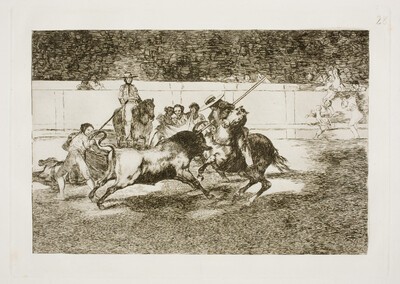- Cronología
- 1814 - 1816
- Dimensiones
- 244 x 351 mm
- Técnica y soporte
- Aguafuerte, aguatinta, punta seca, buril y bruñidor
- Reconocimiento de la autoría de Goya
- Documented work
- Ficha: realización/revisión
- 02 Oct 2021 / 22 Jun 2023
- Inventario
- -
- Otros títulos:
-
27 (print, upper right-hand corner)
See How the ancient Spaniards hunted bulls on horseback in the countryside.
Two state proofs are preserved, one before aquatinting and the other before inscribing the number.
The plate is kept at the National Chalcography (nº 360).
See How the ancient Spaniards hunted bulls on horseback in the countryside.
This scene depicts the encounter between a picador and his horse and the bull, who looks defiantly at them, while in the background of the composition other actions are taking place. Thus, in the background on the left, we see another picador on his horse and a couple of men in capes, while beside him on the ground lies another horse, wounded or dead. Behind the main picador is a man who seems to be holding a cape and, almost covered by the horse, another pair of men. They are three labourers assisting the picador. Further back, in the centre, the silhouettes of another two labourers are silhouetted against the barrier, but are very blurred, probably so as not to detract from the foreground, in which the heads of the bull and the horse of the main group stand out.
With regard to these blurred figures, several authors, including Beruete, point out the rarity of the fact that Goya left such apparently unfinished silhouettes. Beruete also points out that the horse ridden by the main picador is the only one in the entire series of the Bullfighting. Martínez-Novillo, for his part, interprets the two blurred silhouettes in the background as two figures that Goya may have wanted to erase but finally chose to leave there.
The main picador depicted in this print is none other than Fernando del Toro from Almonte, the most famous picador of the third quarter of the 18th century. He fought in Madrid in 1766 and the Court also requested him as picador in 1769, through the mediation of the Duke of Medina-Sidonia.
Holo discusses Goya's possible sources of inspiration for the work, the most likely in his opinion being popular prints. He places this engraving among those that speak of renowned bullfighters, narrate abuses of the animal and describe man's irrational behaviour in the light of the Enlightenment, so strongly advocated by Goya.
Due to its subject matter, the work is related to other prints in the series with famous picadors as protagonists, such as Courage manly of the famous Pajuelera in the Zaragoza bullring or The hard-working Rendón chopping a bull, whose luck died in the Madrid bullring.
There is a preparatory drawing of the present print, also titled The famous Fernando del Toro, barilarguero, forcing the wild beast with his club
-
Grabados y dibujos de Goya en la Biblioteca NacionalBiblioteca NacionalMadrid1946catalogue Elena Páez Ríos
-
Goya en la Biblioteca Nacional. Exposición de grabados y dibujos en el sesquicentenario de su muerteBiblioteca NacionalMadrid1978May - June 1978
-
Grabados de Goya: colección propiedad de la Biblioteca Nacional, que se conserva en su Gabinete deCasa de la Amistad de MoscúMoscow1979exhibition displayed from January 18th to 31st 1979
-
1984
-
Madrid1987
-
Madrid1990
-
Goya grabadorFundación Juan MarchMadrid1994consultant editors Alfonso E. Pérez Sánchez and Julián Gállego, from January 14th to March 20th 1994
-
Goya grabadorMuseo del Grabado Español ContemporáneoMarbella1996from March 8th to May 5th 1996
-
Zaragoza1996
-
Ydioma universal: Goya en la Biblioteca NacionalBiblioteca NacionalMadrid1996from September 19th to December 15th 1996cat. 276
-
Schlaf der Vernunft. Original radierungen von Francisco de GoyaMunich2000
-
Madrid2002
-
Madrid2002
-
Bilbao2012
-
Goya et la modernitéPinacothèque de ParisParís2013from October 11st 2013 to March 16th 2014cat. 36
-
Zaragoza2017
-
MadridBlass S.A.1918p. 135
-
1946pp. 177-216, espec. p. 203
-
BarcelonaTartessos-F. Oliver Branchfelt1946 (reed. 1951)
-
1961pp. 120-127
-
OxfordBruno Cassirer1964vol. II, 1964, p. 343, cat. 230
-
Vie et ouvre de Francisco de GoyaParísOffice du livre1970p. 279, cat. 1204
-
MilwakeeMilwaukee Art Museum1986pp. 26 y 32
-
Goya, toros y torerosMadridMinisterio de Cultura, Comunidad de Madrid1990p. 110, cat. 43
-
MadridCaser-Turner1992p. 35
-
Catálogo de las estampas de Goya en la Biblioteca NacionalMadridMinisterio de Educación y Cultura, Biblioteca Nacional1996cat. 352
-
Ydioma universal: Goya en la Biblioteca NacionalMadridBiblioteca Nacional, Sociedad Estatal Goya 96 y Lunwerg1996p. 248
-
MadridMuseo Nacional del Prado2001pp. 86-88
-
ParísPinacoteca de París2013p. 109
-
Goya. In the Norton Simon MuseumPasadenaNorton Simon Museum2016pp. 186-201



